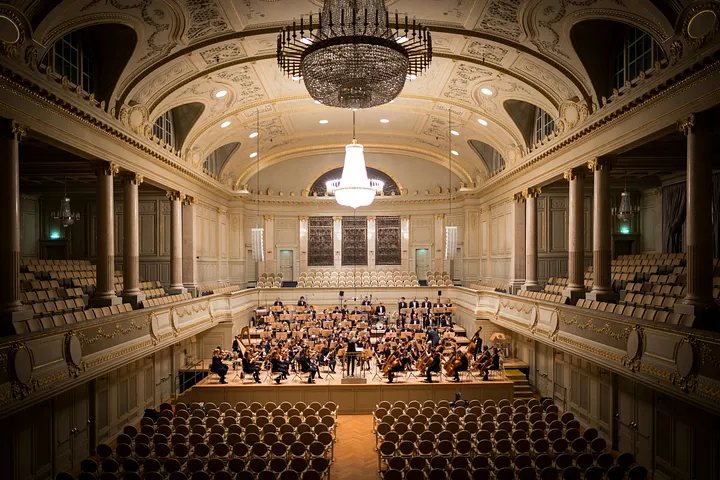Samples of Classical Music in the Modern Era

A true indication of the evolution of what we hear
There’s a good reason for why I titled this article the way I did. It is not to suggest that modern artists are frauds who steal ideas and concepts from music gods.
“I’ve taken stuff from people, too. You know though, you steal from one person, you’re just a thief. But if you steal from everyone, that’s research.” ~ Tony Bennett.
That sentiment is what has carried the evolution of music forward into today’s world. However, a lot of theories, practices and concepts from the classical era and before are evident in music today. Some are obvious, some aren’t, but a true connoisseur of music will be able to at least understand the logic.
Green Day & Johann Pachelbel
https://cdn.embedly.com/widgets/media.html?src=https%3A%2F%2Fopen.spotify.com%2Fembed%2Ftrack%2F6L89mwZXSOwYl76YXfX13s%3Futm_source%3Doembed&display_name=Spotify&url=https%3A%2F%2Fopen.spotify.com%2Ftrack%2F6L89mwZXSOwYl76YXfX13s&image=https%3A%2F%2Fimage-cdn-ak.spotifycdn.com%2Fimage%2Fab67616d00001e02db89b08034de626ebee6823d&type=text%2Fhtml&schema=spotifyReleased in 1994.
There is a long list of songs that use the same melodic structure as Pachelbel’s Canon in some variation. So, I could’ve picked just about any song to make this matchup, but I chose this Green Day song to show just how much audible contrast there is texturally. They almost couldn’t sound more different in the 300+ years that separate them, yet these two songs share a something vital in common in their melodic structures.
https://cdn.embedly.com/widgets/media.html?src=https%3A%2F%2Fopen.spotify.com%2Fembed%2Ftrack%2F0NAZk4tev38aggzECb4Y93%3Futm_source%3Doembed&display_name=Spotify&url=https%3A%2F%2Fopen.spotify.com%2Ftrack%2F0NAZk4tev38aggzECb4Y93&image=https%3A%2F%2Fimage-cdn-ak.spotifycdn.com%2Fimage%2Fab67616d00001e0290b7737da9a7e3ff1531ae6f&type=text%2Fhtml&schema=spotifyReleased in 2009.
Britney Spears & Antonio Vivaldi
https://cdn.embedly.com/widgets/media.html?src=https%3A%2F%2Fopen.spotify.com%2Fembed%2Ftrack%2F6naxalmIoLFWR0siv8dnQQ%3Futm_source%3Doembed&display_name=Spotify&url=https%3A%2F%2Fopen.spotify.com%2Ftrack%2F6naxalmIoLFWR0siv8dnQQ&image=https%3A%2F%2Fimage-cdn-fa.spotifycdn.com%2Fimage%2Fab67616d00001e02c50b7d96737041f4bfd844d6&type=text%2Fhtml&schema=spotifyReleased in 2000.
Much like “Basket Case” with Pachelbel’s “Canon in D”, this song by Britney Spears utilizes the melodic structure of Vivaldi’s “La Follia.” That said, it’s also where it differentiates completely. While the melodic structure of “Basket Case” was a variation of “Canon in D” instrumentally, the structure of “La Follia” is heard vocally in “Oops!… I Did It Again.” This is a great example of highlighting the versatility of music, because melodies written in the 1600’s for string instruments are now being used in the modern era vocally.
https://cdn.embedly.com/widgets/media.html?src=https%3A%2F%2Fopen.spotify.com%2Fembed%2Ftrack%2F31phRRDd6MwLhE88ZXt8hn%3Futm_source%3Doembed&display_name=Spotify&url=https%3A%2F%2Fopen.spotify.com%2Ftrack%2F31phRRDd6MwLhE88ZXt8hn&image=https%3A%2F%2Fimage-cdn-ak.spotifycdn.com%2Fimage%2Fab67616d00001e02e26bb62221cb00703dde5915&type=text%2Fhtml&schema=spotifyReleased in 2005.
Lady Gaga & Vittorio Monti
https://cdn.embedly.com/widgets/media.html?src=https%3A%2F%2Fopen.spotify.com%2Fembed%2Ftrack%2F4lwavw59UjXUPJZtKNdFYp%3Futm_source%3Doembed&display_name=Spotify&url=https%3A%2F%2Fopen.spotify.com%2Ftrack%2F4lwavw59UjXUPJZtKNdFYp&image=https%3A%2F%2Fimage-cdn-ak.spotifycdn.com%2Fimage%2Fab67616d00001e02bfd247438980173d32fd5ba8&type=text%2Fhtml&schema=spotifyReleased in 2009.
It’s not so subtle with Lady Gaga’s song here. The strings heard in the beginning of “Alejandro” are almost exactly a cut-and-dry sample of Monti’s “Csárdás.” While this is more so paying homage to the origin of much of the music that exists today, the sampling of Monti’s music was not used in the kind of interpretation that other songs in this article are highlighted to have done.
https://cdn.embedly.com/widgets/media.html?src=https%3A%2F%2Fopen.spotify.com%2Fembed%2Ftrack%2F6lo128WdLt7xP5Ejvsq1ym%3Futm_source%3Doembed&display_name=Spotify&url=https%3A%2F%2Fopen.spotify.com%2Ftrack%2F6lo128WdLt7xP5Ejvsq1ym&image=https%3A%2F%2Fimage-cdn-ak.spotifycdn.com%2Fimage%2Fab67616d00001e020114c928a40a0ed169537f0d&type=text%2Fhtml&schema=spotifyReleased in 2010.
Eric Carmen/Celine Dion & Sergei Rachmaninoff
https://cdn.embedly.com/widgets/media.html?src=https%3A%2F%2Fopen.spotify.com%2Fembed%2Ftrack%2F0AQqrtK1pULuwZUXhwaaDz%3Futm_source%3Doembed&display_name=Spotify&url=https%3A%2F%2Fopen.spotify.com%2Ftrack%2F0AQqrtK1pULuwZUXhwaaDz&image=https%3A%2F%2Fimage-cdn-ak.spotifycdn.com%2Fimage%2Fab67616d00001e028b62f896e8d3ca8dad7588e7&type=text%2Fhtml&schema=spotifyReleased in 1975.
While Celine Dion’s rendition of “All By Myself” became the more popular version, it’s Eric Carmen’s original melodic vocal structure that borrows from Rachmaninoff’s “Adagio sostenuto” more concisely. Dion’s iteration was elevated by at least a few whole steps in its key signature to allow her to show off her vocal range, but if you listen to Eric Carmen’s and then listen to Rachmaninoff’s second movement of his piano concerto, you’ll hear the similarities.
https://cdn.embedly.com/widgets/media.html?src=https%3A%2F%2Fopen.spotify.com%2Fembed%2Ftrack%2F4rrrn8OLrttq7r9RgNXalU%3Futm_source%3Doembed&display_name=Spotify&url=https%3A%2F%2Fopen.spotify.com%2Ftrack%2F4rrrn8OLrttq7r9RgNXalU&image=https%3A%2F%2Fimage-cdn-fa.spotifycdn.com%2Fimage%2Fab67616d00001e028e6adfe4421d106633abde7b&type=text%2Fhtml&schema=spotifyReleased in 2012.
Alice Cooper & Frédéric Chopin
https://cdn.embedly.com/widgets/media.html?src=https%3A%2F%2Fopen.spotify.com%2Fembed%2Ftrack%2F1JyNPbzE7t1RUsbpiryGHJ%3Futm_source%3Doembed&display_name=Spotify&url=https%3A%2F%2Fopen.spotify.com%2Ftrack%2F1JyNPbzE7t1RUsbpiryGHJ&image=https%3A%2F%2Fimage-cdn-ak.spotifycdn.com%2Fimage%2Fab67616d00001e02f2f4f42443aa30df2252a0ae&type=text%2Fhtml&schema=spotifyReleased in 1976.
It certainly helps when there’s an instrument in common. So, when listening to the intro to Alice Cooper’s song and Chopin’s “Fantaisie-Impromptu,” you don’t have to use your imagination too much to hear the resemblances in the chord progressions. While it isn’t a direct cut-and-paste of Chopin’s work into Alice Cooper’s song, the overall texture of the piano levels up the similarity that these two vastly different pieces of art share.
https://cdn.embedly.com/widgets/media.html?src=https%3A%2F%2Fopen.spotify.com%2Fembed%2Ftrack%2F6eZFiHEV6nKcEJj3EHkeWU%3Futm_source%3Doembed&display_name=Spotify&url=https%3A%2F%2Fopen.spotify.com%2Ftrack%2F6eZFiHEV6nKcEJj3EHkeWU&image=https%3A%2F%2Fimage-cdn-ak.spotifycdn.com%2Fimage%2Fab67616d00001e020e32d0240e69d9688561606c&type=text%2Fhtml&schema=spotifyReleased in 2019.
I first learned about this phenomenon in a music course I took in university, and it will forever fascinate me. I’m always going to have it in the back of my mind that some new song coming out today, tomorrow or next week will have some crazy connection to Bach, Mozart or Puccini. With that said, music is as generationally interconnected as it’s cracked up to be, and that lore will continue to be written in the stars for decades and millennia to come.
author https://medium.com/the-riff